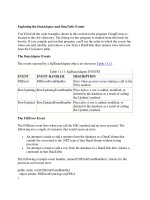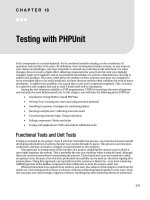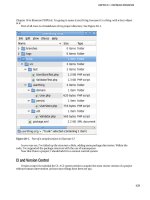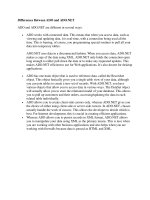Tài liệu Configuring Distribute Lists and Passive Interfaces docx
Bạn đang xem bản rút gọn của tài liệu. Xem và tải ngay bản đầy đủ của tài liệu tại đây (36.47 KB, 7 trang )
1 - 7 Semester 5: Advanced Routing v2.0 - Lab 7.5.1 Copyright 2001, Cisco Systems, Inc.
7.5.1 Configuring Distribute Lists and Passive Interfaces
RIPv2
Full T1:
1.544 Mbps
19.2 Kbps
Singapore
AucklandSanJose3
Fa0/0 192.168.232.1/24
Fa0/1 192.168.236.1/24
S0/0 192.168.224.2/30
S0/1 192.168.240.1/30
S0/0 192.168.224.1/30
S0/0 192.168.240.2/30
Fa0/0 192.168.5.1/24 Fa0/0 192.168.248.1/24
Objective
In this lab, you configure a combination of advanced routing features to optimize routing.
These features include distribute lists, passive interfaces, default routes, and route
redistribution.
Scenario
International Travel Agency (ITA) uses RIPv2 for dynamic routing. You do a performance
analysis to determine whether RIPv2 is optimized.
A very slow 19.2 Kbps link is used to connect Singapore and Auckland until you can
provision a faster link. To reduce traffic, you would like to avoid dynamic routing on this
link.
You notice that one of the LANs with enterprise servers is near saturation. To reduce
traffic, you decide to filter RIPv2 updates from entering SanJose3’s 192.168.5.0/24
Ethernet LAN because the updates serve no purpose.
ITA has a large research and development division in Singapore. The R&D engineers are
on LAN 192.168.232.0 /24. The R&D managers on the 192.168.236.0 /24 LAN need
access to this experimental network, but you also want this LAN to be “invisible” to the
rest of the company. Also, the two R&D LANs have many UNIX hosts that need to
exchange RIPv2 updates with the Singapore router.
2 - 7 Semester 5: Advanced Routing v2.0 - Lab 7.5.1 Copyright 2001, Cisco Systems, Inc.
Step 1
Build and configure the network according to the diagram, but do not configure RIPv2 yet.
Use ping to verify your work and test connectivity between the serial interfaces. (Note:
Auckland should not be able to ping SanJose3 until you have made additional
configurations.)
Step 2
On SanJose3, configure RIPv2 to advertise both connected networks, as shown here:
SanJose3(config)#router rip
SanJose3(config-router)#version 2
SanJose3(config-router)#network 192.168.224.0
SanJose3(config-router)#network 192.168.5.0
No routers or hosts on SanJose3’s Ethernet LAN need RIPv2 advertisements. However,
if you don’t include the 192.168.5.0 network in the RIPv2 configuration, SanJose3 will not
advertise the network to Singapore. However, you can configure FastEthernet 0/0 as a
passive interface, keeping FastEthernet 0/0 from sending RIPv2 updates. Use the
following commands:
SanJose3(config)#router rip
SanJose3(config-router)#passive-interface fastethernet0/0
RIPv2 updates will no longer be sent via E0.
Step 3
Now configure RIPv2 on Singapore. At this point, enable RIPv2 only on the
192.168.224.0 /30 network so that Singapore can exchange routing information with
SanJose3:
Singapore(config)#router rip
Singapore(config-router)#version 2
Singapore(config-router)#network 192.168.224.0
After you enter this RIPv2 configuration on Singapore, check SanJose3’s routing table
with the show ip route command. Note that SanJose3 has not learned any routes via
RIPv2:
SanJose3#show ip route
<output omitted>
C 192.168.5.0/24 is directly connected, FastEthernet0/0
C 192.168.224.0/24 is directly connected, Serial0/0
1. Why hasn’t SanJose3 learned about 192.168.232.0 /24 and 192.168.236.0 /24?
RIP has not been configured on Singapore to advertise the Ethernet networks. Also, RIP
will not advertise a route for 192.168.224.0/30 out interface serial 0/0, where the network
resides.
3 - 7 Semester 5: Advanced Routing v2.0 - Lab 7.5.1 Copyright 2001, Cisco Systems, Inc.
Step 4
After you review network requirements, you decide to enable RIPv2 on Singapore’s
FastEthernet 0/0 and FastEthernet 0/1 so that UNIX hosts on these LANs can receive
routing information:
Singapore(config)#router rip
Singapore(config-router)#Version 2
Singapore(config-router)#network 192.168.232.0
Singapore(config-router)#network 192.168.236.0
RIPv2 is now sending updates to these networks, as required by the UNIX hosts. Check
SanJose3’s table again:
SanJose3#show ip route
Gateway of last resort is not set
192.168.224.0/30 is subnetted, 1 subnets
C 192.168.224.0 is directly connected, Serial0/0
C 192.168.5.0/24 is directly connected, FastEthernet0/0
R 192.168.232.0/24 [120/1] via 192.168.224.2, 00:00:13,
Serial0/0
R 192.168.236.0/24 [120/1] via 192.168.224.2, 00:00:09,
Serial0/0
The network command enables RIP updates on interfaces within that major network
and advertises those networks out all other RIP-enabled interfaces. SanJose3 now has
routes to 192.168.232.0 /24 (which is good) and 192.168.236.0 /24 (which is bad).
Remember that you want to keep this network invisible to the rest of the company.
Step 5
To stop Singapore from sending updates about 192.168.236.0 /24 (without disabling
RIPv2 for that network), you can remove it from outgoing updates with the distribute-
list command. Distribute lists allow you to filter the contents of incoming or outgoing
routing updates.
Because you want to filter 192.168.236.0 /24 from outgoing updates to all their routers,
use the following commands:
Singapore(config)#access-list 1 deny 192.168.236.0
Singapore(config)#access-list 1 permit any
Singapore(config)#router rip
Singapore(config-router)#distribute-list 1 out
4 - 7 Semester 5: Advanced Routing v2.0 - Lab 7.5.1 Copyright 2001, Cisco Systems, Inc.
Verify that this filter has been applied by issuing the show ip protocols command on
Singapore.
Singapore#show ip protocol
Routing Protocol is "rip"
Sending updates every 30 seconds, next due in 4 seconds
Invalid after 180 seconds, hold down 180, flushed after 240
Outgoing update filter list for all interfaces is 1
Incoming update filter list for all interfaces is
Redistributing: rip
Default version control: send version 2, receive version 2
Interface Send Recv Triggered RIP Key-chain
FastEthernet0/0 2 2
Serial0/0 2 2
FastEthernet0/1 2 2
Routing for Networks:
192.168.224.0
192.168.232.0
192.168.236.0
Passive Interface(s):
Serial0/1
Routing Information Sources:
Gateway Distance Last Update
192.168.224.1 120 00:00:03
Distance: (default is 120)
1. According to the output of this command, which interface is the outgoing update filter list
applied to?
You should see that the list is applied to all RIP-enabled interfaces.
With the distribute list configured on Singapore, return to SanJose3 and flush the routing
table with the clear ip route * command. Wait at least 5 seconds, and then use
show ip route to check SanJose3’s table:
SanJose3#show ip route
Gateway of last resort is not set
192.168.224.0/30 is subnetted, 1 subnets
C 192.168.224.0 is directly connected, Serial0/0
C 192.168.5.0/24 is directly connected, FastEthernet0/0
R 192.168.232.0/24 [120/1] via 192.168.224.2, 00:00:01,
Serial0/0
2. Is the route to 192.168.236.0 /24 in SanJose3’s table? Is the route to 192.168.232.0 /24 in
SanJose3’s table?
The distribute list should have removed 192.168.236.0/24 from further RIP updates.
192.168.232.0/24 should be the only RIP route in SanJose3’s table at this point.
5 - 7 Semester 5: Advanced Routing v2.0 - Lab 7.5.1 Copyright 2001, Cisco Systems, Inc.
Step 6
SanJose3’s table is almost complete, but it does not yet include a route to 192.168.240.0
/30, which is directly connected to Singapore. You could enter a network command in
Singapore’s RIPv2 configuration so that it will advertise this network. Of course, you do
not want RIPv2 updates sent out the 19.2 Kbps link, so you would have to place
Singapore’s S0/0 into passive mode. But there is another alternative. You can configure
Singapore to redistribute connected networks into RIPv2. Enter the following commands
on Singapore:
Singapore(config)#router rip
Singapore(config-router)#redistribute connected
Singapore(config-router)#no auto-summary
When you issue these commands, Singapore imports all directly connected routes into
the RIP process. Thus, 192.168.240.0 /30 will be redistributed into RIPv2 and sent to
SanJose3 as part of each RIPv2 update. Verify your configuration by issuing the following
command on Singapore:
Singapore #show ip route 192.168.240.1
Routing entry for 192.168.240.0/30
Known via "connected", distance 0, metric 0 (connected,
via interface)
Redistributing via rip
Advertised by rip
Routing Descriptor Blocks:
* directly connected, via Serial0/0
Route metric is 0, traffic share count is 1
The output of this command should confirm that this connected route is being
redistributed and advertised by RIPv2.
Check SanJose3’s routing table:
SanJose3#show ip route
Gateway of last resort is not set
192.168.224.0/30 is subnetted, 1 subnets
C 192.168.224.0 is directly connected, Serial0/0
192.168.240.0/30 is subnetted, 1 subnets
R 192.168.240.0 [120/1] via 192.168.224.2, 00:00:02,
Serial0/0
C 192.168.5.0/24 is directly connected, FastEthernet0/0
R 192.168.232.0/24 [120/1] via 192.168.224.2, 00:00:02,
Serial0/0
SanJose3 should now have RIPv2 routes to both 192.168.240.0 /30 and 192.168.232.0
/24.









